The Black-Eyed White
Recipe
Book
Black Eyed Whites
Pure white and pure black
animals have always been more popular than the more mundane colors in between,
but a lot of people find the common lab mouse, white with pink eyes, to be kind
of spooky. Something about those little beady pink eyes, and perhaps a
collective guilt over the large numbers of these creatures who’ve been used in
laboratories to make our lives easier, makes them less than desireable pets.
Perhaps this is why white mice with black eyes have been fondly sought
after in ways that albino mice haven’t. It could also have a lot to do with the
fact that the albino gene which creates the white lab mice is easily used, and
to get albino mice is an easy enough task, while breeding a mouse that is white
with black eyes is a lot more difficult. Whatever the case might be, these
beautiful white animals with shining black eyes have captured my heart as much
as they have captured the hearts of other mouse fanciers.
Double Banding
To begin with, in my very
first mouse litters I got a black eyed white baby. I barely knew anything about
mouse genetics at that time, but in an effort to understand how I got a black
eyed white mouse from a brown banded mouse and a silver banded mouse, I began
to study up on genetics. Now my understanding is much deeper and it is for that
reason that I’m sharing my knowledge with you, the reader.
The two mice who had babies
were Sara, whom I learned was an agouti banded mouse with a head spot, and
Onion, who was a “mock” silver agouti banded mouse. One website referred to a
mouse with only one cch (chinchilla) gene and with a c (albino) gene
as mock silver agouti. The term works for me, and this is what Onion was. When
bred together, the first litter of four babies had one baby who was agouti, one
agouti banded, a silver agouti broken marked, and a black-eyed white baby (I’ll
refer to it as BEW from this point on). In the picture below this baby was the
one in the upper left hand corner. He was taken to a pet store to be sold as a
pet. In Sara’s second litter, she had two more BEW babies. One was Bess, in the
picture below, and the other BEW baby in the picture was the other one. The boy
also went to the pet store, but I kept Bess.
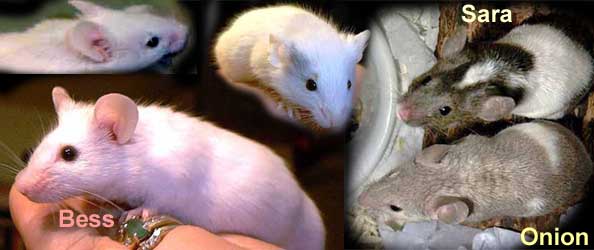
Upon researching banded
mice, where the technical name for the gene which causes the banding is KitW-sh,
I learned that when a mouse is homozygous for this gene (has two banding genes
instead of just one), the mouse will usually be BEW. Occasionally the mouse will have some small pigment around the
ears, eyes, or tail. In the case of my three double banded mice, the first one
had a small round spot of gray on one ear, and a similar spot on his tail
shaft. Bess has a smudge on one ear, and her brother had a patch of gray over
one eye which is apparent in the photograph. With selective breeding of double
banded mice to one another, choosing those with the least amount of “smudging”
a very beautiful black-eyed white mouse could be developed.
Extreme Dilution Gene
The extreme dilution gene ce
when combined with Ay yellow genes can cause BEW mice. When bred
together these mice have coffee, cream and BEW offspring. In my case the two
parent mice were a sooty brindle named Pepper, and a banded brindle named Olivia.
When bred together two of the offspring were not only satin, they were
mysteriously BEW. As they get older, their coloring is darkening, so at this
time I’m calling them Black-Eyed Platiunum mice. They are like white gold. When
they are adult, I plan to update this article with pictures of them next to a
true BEW satin mouse, to demonstrate the difference. While I am not certain
that it is the extreme dilution gene which is responsible, it seems to be the
only possibility. If this is the case then when bred to other mice with the
extreme dilution gene, as I may have, then they should result in some further
BEW offspring.
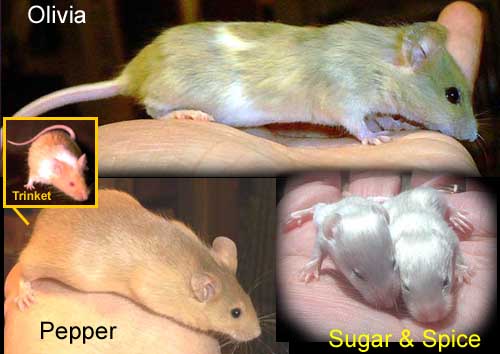
Marked Mice
Another way to achieve BEW
babies, is to selectively breed marked mice together, breeding the mice with
the fewest markings until finally you have a mouse where the only markings are
the pigment in the eyes. This method can work but is not always the quickest
way to get a genetically stable line of BEW mice. Several of the marking genes,
combined together, can often increase your chances of getting a BEW mouse, for
example the W gene, responsible for variegated mice, can be combined into
homozygous piebald spotted mice. The idea is that if one spotting gene wipes
out the spots left behind by the first spotting gene, you are left with a BEW
mouse. Care must be taken when trying this approach as there are a number of
risks involved with the white spotting genes. Homozygous variegated W mice are
anemic and usually die in the first weeks of life. The spotting piebald gene
has also been known to cause megacolon in mice and this is a fatal defect which
results in a painful death. One of my mystery BEW mice I am placing into this
category, though truthfully I am not sure if this is a case of marking genes,
or other genetic problems, as Itsy, the mouse in question, is still young, but
her coat is unusual, and her size tiny. She is the offspring of Ingrid, an
albino mouse, and Charlie, a marked mouse, who is himself an offspring of Sara
and Onion, though the fact that some of his offspring were not banded reveals
that he was not double banded as was suspected earlier in his life.
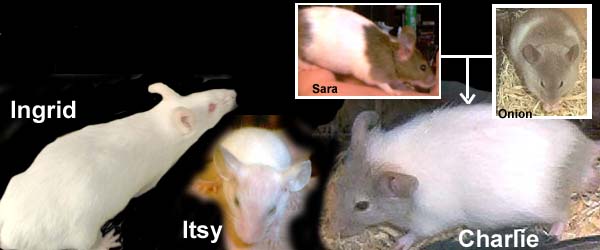
Chinchilla
The chinchilla gene cch
dilutes the yellow pigment of a mouse’s coat and makes it white. When it is
mixed with an agouti mouse, the result is a silver agouti mouse. When a fawn
mouse gets the chinchilla gene also, the result is a BEW mouse. In my case the
parent mice were Foxy, who was the Berkshire marked fawn offspring of a broken
marked fawn mother and unknown father, and Onion. This meant that the two
black-eyed white mice born in her first litter of ten babies was a chinchillated
fawn baby with one albino gene “c” and one chinchilla gene. Several sources say
that only a double doseof the chinchilla gene would work it’s magic, but since
the Chinchilla gene is dominant over the albino, it makes sense that only one
chinchilla gene is necessary to wash out the yellow in an otherwise fawn coat.
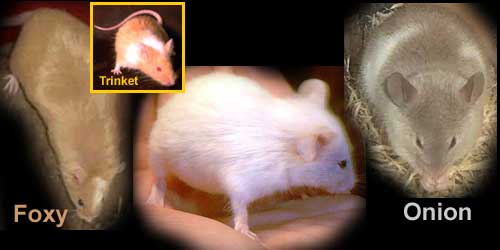
Other Methods
Sometimes a mouse is BEW
without any explanation. Normally a BEW mouse will not have BEW offspring
unless the mice being bred are carefully selected for specific genetic traits.
Ivory, the one BEW mouse I purchased, who was a satin mouse, was bred to Sage,
a long-haired satin broken-marked pink-eyed fawn. Her five offspring included
an agouti banded, red banded, gold broken-marked, agouti broken-marked, and one
inexplicable black eyed white baby who looked just like his mama and who was
named Caspar. It could be that he inherited a dilution gene from the father and
a chinchilla gene from the mother, but until he begins to have offspring, he’ll
just be the mystery mouse in all of Mousedom.
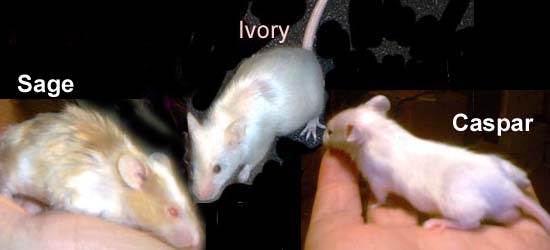
Mousedom BEW Mice
Mousedom is currently
breeding Caspar to his dam, Ivory, as well as to the above mentioned female
mice, Roxy, and Bess. When they are of age, Caspar will be bred to Sugar and
Spice as well, and if Itsy is ever up to being bred, and is fertile, she, too
will be introduced to Caspar to try to obtain more of these beautiful mice.
Conclusion
To obtain a black-eyed white
mouse through selective breeding is a very hit-and-miss procedure. There are
some methods of working to get Black-Eyed whites that will produce animals
which are close, but it is not an easy procedure. The best way to procure a BEW
mouse is to find one in a petstore and purchase it. BEW mice are beautiful
additions to the mouse fancy, and charming creatures. Mousedom is devoted to
the propagation of these beautiful creatures through the methods mentioned
above. As more BEW mice are produced, the methods of producing them will be
chronicled here, and their picture, along with the known parent mice will be
added to this document.